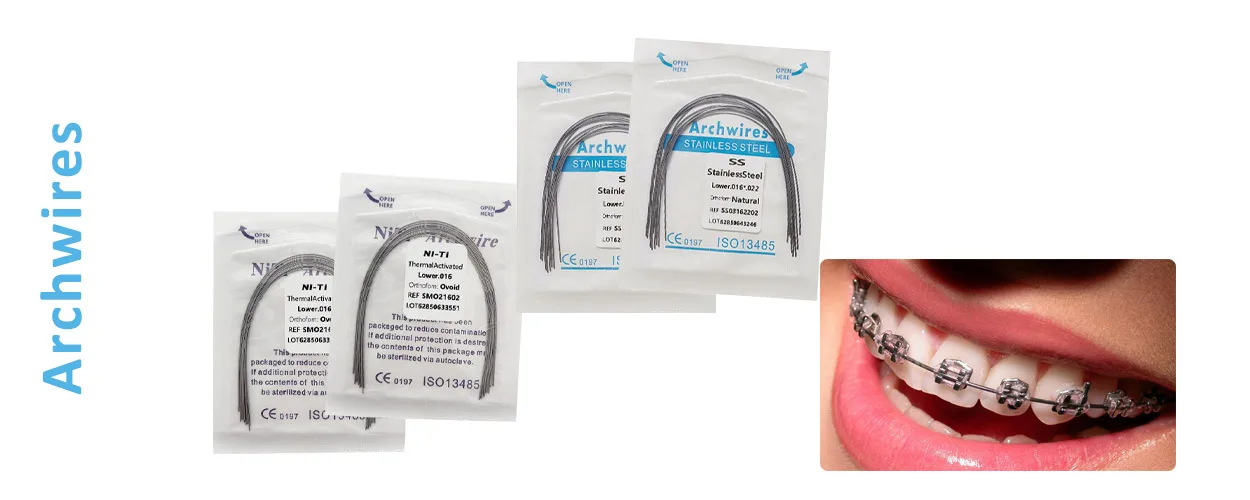En traitement orthodontique, Archwire est l'un des composants principaux du système de correction du support. Si vous êtes un orthodontiste ou un chef d'achat dentaire, Cet article analysera les fonctionnalités techniques, Scénarios d'application et suggestions d'achat d'arcs orthodontiques dans une perspective professionnelle, Vous aider à faire correspondre vos besoins cliniques plus efficacement.
1. Que sont les arches orthodontiques?
Mince, les fils métalliques flexibles fixés aux brackets dentaires sont appelés arcs orthodontiques. Au fil du temps, ces fils déplacent progressivement les dents dans la bonne position en appliquant de la lumière, pression continue. Ces fils sont connus sous le nom “arcs métalliques,” et l'arcade inférieure est formée par les fils sur les dents inférieures, tandis que l'arcade supérieure est formée par les fils métalliques sur les dents supérieures.
Ils agissent comme un moteur guidant pour les dents et sont essentiels pour contrôler le mouvement des dents. Sans, Vos dents tordues ne bougeraient jamais. Ces fils d'accès sont disponibles en différentes tailles et ont des compositions de matériaux différentes.
2. Quelle est la fonction des archhiches?
En tant que composant mécanique dynamique du système orthodontique, les arcs orthodontiques réalisent un mouvement passif des dents grâce à un mécanisme de compression précis. Pendant la phase initiale du traitement, les orthodontiologues sélectionnent des arcs en alliage nickel-titane avec un module élastique approprié. Leurs propriétés de mémoire de forme peuvent appliquer une force orthodontique continue de 0.5 à 1,5N/cm² à la dentition mal alignée. Cette stimulation mécanique déclenche le remodelage osseux alvéolaire en activant la prolifération des ostéoclastes côté pression et des ostéoblastes côté tension., atteindre un déplacement mensuel de 0.1 à 1mm pour les dents.
Les pwires remplissent trois fonctions essentielles:
| Guide vectorielle | Établir une courbure idéale de l'arc dentaire grâce à la mise en forme de fil préformé |
| Livraison de force | Traduction de contraintes du système de support en mouvement dentaire directionnel |
| 3D Control | Réglage de l'inclinaison axiale et du positionnement en rotation via l'ingénierie du couple |
Le mécanisme de réglage dynamique s'étend sur tout le cycle de traitement: un suivi est effectué chaque 4 à 6 semaines, et les orthodontistes maintiennent la force orthodontique optimale de 20 à 150g/cm en remplaçant l'arc. Aux stades intermédiaire et ultérieur du traitement, il passe à l'étape de l'arc en acier inoxydable (0.016×0,022 pouces à 0,019×0,025 pouces), avec un module élastique de 210GPa. Cela permet la mise en place d'un système mécanique tridimensionnel précis, permettant une régulation fine du mouvement de la pointe des racines et de l'occlusion.
La théorie en trois étapes du profit (Profit, Champs, & Sarver, 2018) est suivi par ce système biomécanique: alignement initial → contrôle vertical → réglage fin du couple, ce qui conduit à 80 à 90 % de repositionnement de l’arcade dentaire et à une reconstruction occlusale fonctionnelle. Selon les données cliniques, l'application standardisée du système d'arcs permet de maintenir le taux de résorption radiculaire en dessous du seuil de sécurité (< 2MM) et augmenter l'efficacité du traitement orthodontique en 40%.
3. La science derrière les arcs orthodontiques
Le fil d’arc d’aujourd’hui est une merveille d’ingénierie, contrairement à l'orthodontie’ approche homogène au début du 20ème siècle. La science des matériaux détient la clé de leur succès: le bon choix d’alliage a un impact direct sur la vitesse de traitement, confort, et résultat.
Pensez à NiTi (nickel-titane) fil. Presque personne n'avait prévu que NiTi aurait un potentiel dentaire lorsque le Dr. William J. Buehler a d'abord remarqué son “mémoire de forme” qualités au Laboratoire de Recherche Navale dans les années 1960. Ces jours, cet alliage est une solution majeure au problème des dents encombrées car il peut “souviens-toi” la forme idéale de l’arcade dentaire du patient et peut résister jusqu’à 8% souche (alors que l'acier ne peut résister 1%).
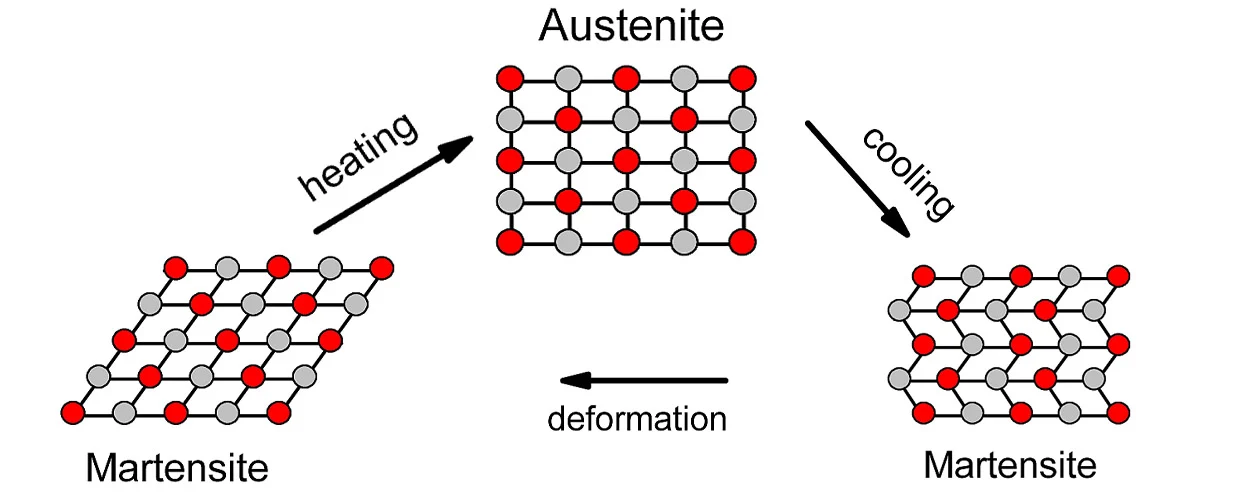
4. Classification des arches orthodontiques
Les arcs orthodontiques peuvent être classés en trois types principaux en fonction des différentes propriétés des matériaux.:
UN. Arcwires nickel-titanium (Niti)
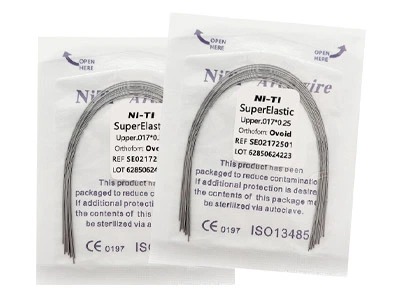
B. Arc en acier inoxydable
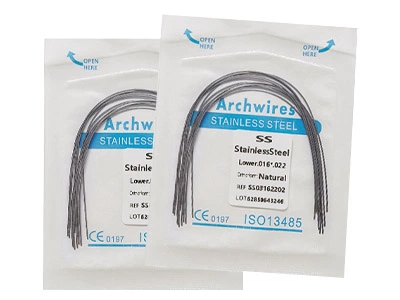
C. Beta-Titanium Archwire
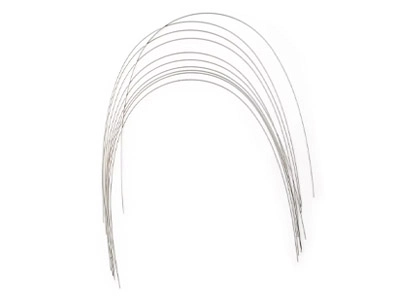
5. Critères de sélection clinique pour les arcs orthodontiques
Faire correspondre l'élasticité à la résistance selon l'étape de traitement
Pour une première correction, les arcs superélastiques en nickel-titane doivent être prioritaires pour réduire l'inconfort du patient. Aux étapes intermédiaire et ultérieure, les fils d'arc en acier inoxydable ou en titane β sont remplacés pour contrôler avec précision la force.
Focus sur le processus de traitement de surface
Les fils d'arc de haute qualité doivent avoir une surface lisse (comme le polissage électrochimique) pour réduire la friction des brackets et éviter les irritations des muqueuses.
Dimensions standardisées et performances de la mémoire
Sélectionnez des arcs qui répondent à l'AAO (Association américaine d'orthodontie) normes pour garantir la compatibilité avec les systèmes de supports traditionnels et une stabilité élevée à mémoire de forme.
6. Suggestions d’utilisation clinique et d’entretien
- Le cycle de remplacement des arcs: La vitesse de déplacement des dents du patient et le niveau de fatigue des arcs orthodontiques déterminent la fréquence d’ajustement de ceux-ci., ce qui est généralement tous les 6 à 8 semaines.
- Conseils aux patients: N'oubliez pas de ne pas mâcher d'objets durs, appliquer de la cire orthodontique pour soulager tout inconfort initial causé par la friction, et nettoyez régulièrement l'arc pour éviter l'accumulation de plaque dentaire..
- Exigences de stockage: Pour éviter l'oxydation ou la déformation, les fils d'arc non ouverts doivent être conservés dans une atmosphère sèche.
7. Pourquoi choisir notre Vitesses orthodontiques?
En tant qu'exportateur spécialisé dans la recherche et le développement de consommables dentaires pour 15 années, Nous offrons:
Contrôle de qualité strict: Les produits sont ISO 13485 agréé, FDA / CE conforme et lot traçable.
Choix diversifiés: couvrant la gamme complète de tailles de 0,012 ″ à 0,021 × 0,025 ″, Soutenir la personnalisation multi-matériaux comme le nickel-titane, acier inoxydable, bêta-titane et ainsi de suite.
Partage de cas: Solution de fil d'arc pour améliorer l'efficacité de la clinique.
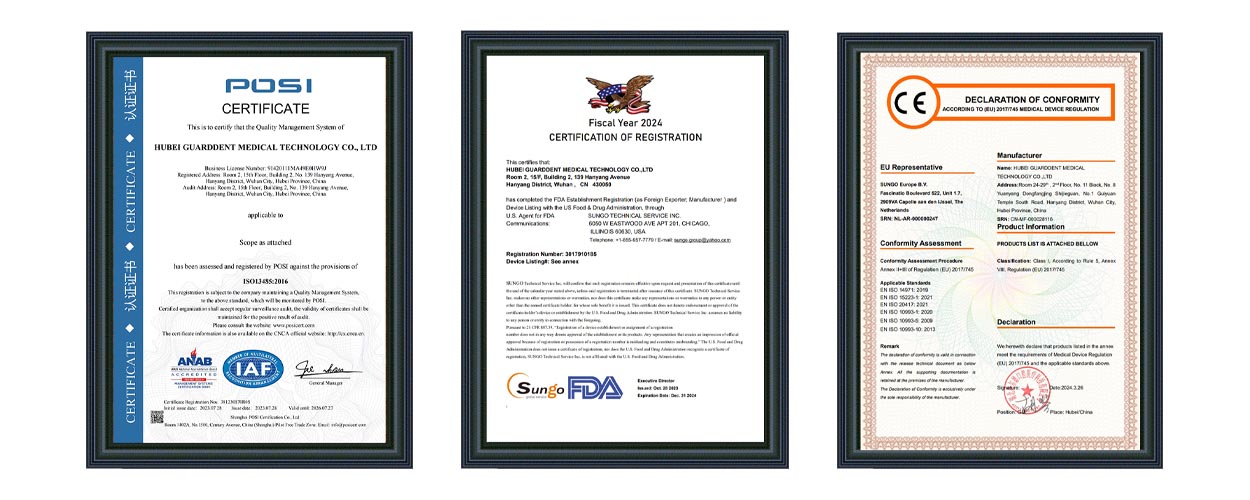
Une chaîne de cliniques dentaires à Barcelone, Espagne, réduit le cycle de traitement moyen des cas initiaux par 15% Et le temps pour les ajustements de suivi par 20% en utilisant nos arcs nitinols. La rétroaction du médecin est que «la stabilité de la mémoire de forme de l'arc-vide réduit considérablement la complexité de l'opération, ce qui convient particulièrement aux adolescents. »
Conclusion
Malgré leur petite taille, les arcs orthodontiques sont des composants essentiels qui influencent l'effet de correction. La sélection du fil d'arc approprié peut stimuler les patients’ confiance dans le déroulement du traitement en plus d'augmenter l'efficacité du diagnostic et du traitement. N'hésitez pas à nous contacter à tout moment si vous souhaitez des échantillons gratuits ou plus d'informations sur nos produits.
Références
- Shah, S. J., Ali, M., & Matthews, M. E. (2015). Matériaux et techniques orthodontiques. Journal of Clinical Orthodontics, 49(8), 23-34.
- Ribeiro, T. K. S. J., Silva, S. UN. S., & da silva, D. P. (2020). Mécanismes biologiques du mouvement des dents: Une revue. Journal européen d'orthodontie, 42(2), 55-64.
- Professeur, W. R., Champs, H. W., & Sarver, D. M. (2018). Orthodontie contemporaine (6thé.). Elsevier.

